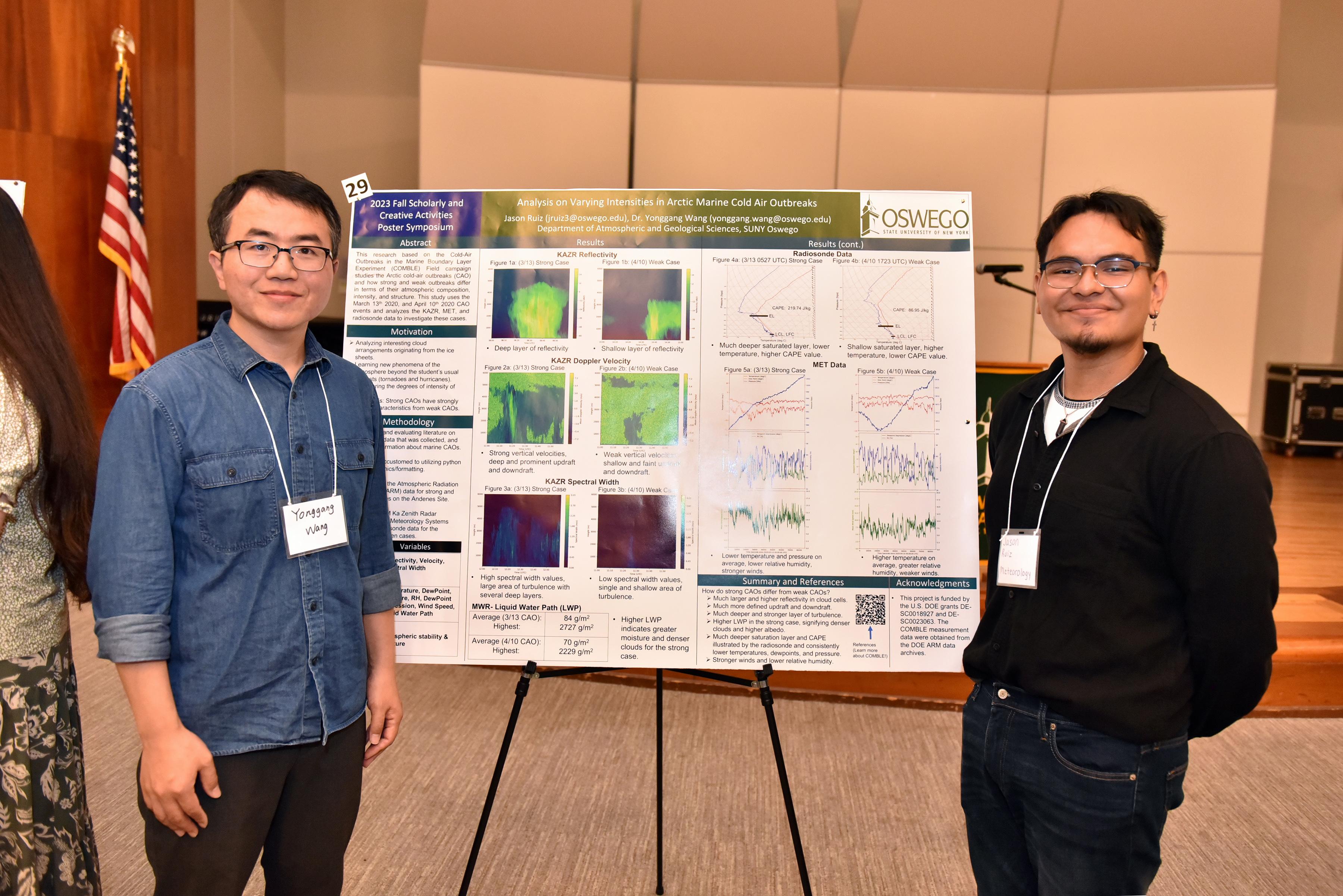Meteorology professor Yonggang Wang and his student Jason Ruiz present their research on Arctic marine cold air outbreaks at the Fall 2023 Scholarly and Creative Activities Poster Symposium.
Yonggang Wang, assistant professor of meteorology at SUNY Oswego, recently received a $234,022 grant from the National Science Foundation (NSF) to support research into cold-air outbreaks (CAOs) in the sub-arctic region, or the CAESAR project.
Wang will take four students with him on the research trip in early 2024. The experiment will use state-of-the-art facilities and will deploy an NSF National Center for Arctic Research (NCAR) C-130 aircraft to document convective clouds during cold-air outbreaks. The clouds can produce heavy snowfall, occasionally generating intense “polar lows” that affect the overall climate of the Arctic. The outbreaks will be studied over the open waters between northern Sweden and the Arctic ice edge from Feb. 22 to April 7, 2024.
The NCAR C-130 aircraft has a 10-hour flight endurance, with a 2,900 nautical mile range at up to 27,000 feet, and can carry up to 13,000 pounds. The team is aiming to use a wide variety of research materials never been used before to study the Arctic CAOs, including radars and lidars, aerosol, cloud, precipitation and trace gas probes. Wang says one research aspect of using this aircraft is similar to that of using a weather balloon. However, those are primarily used over land. The NCAR aircraft will allow the team to study these outbreaks over large bodies of water.
“With the dropsonde system deployed from the aircraft, we can measure the vertical profiles of ambient temperature, pressure, humidity, wind speed and direction above water. After dropsondes are launched from the aircraft, they will fall down to the surface to give us some really nice measurements of the state of the atmosphere, so we are really excited that we have this facility,” Wang explained.
For those not familiar with the subject matter, Wang says the cold-air outbreaks in this region of the world are similar to lake-effect snow patterns in Oswego, intense and unpredictable.
“The forecasting of lake-effect snow bands is also very challenging. Because of their small scales, sometimes the models cannot predict some key variables very accurately,” Wang explained. “Hopefully, the students who are involved in the CAESAR project, and working on the data when it’s done, will understand the characteristics of the cold-air outbreaks, and that will help them better understand lake-effect snow events, so they can make significant contributions to our future forecasting of lake-effect snow, which is really important to the people who live in this area.”
Wang also says current methods of forecasting weather are not as effective in the Arctic area of the world, especially with these specific weather events.
“The numerical weather prediction models we use, and the National Weather Service uses every day, to give us our daily weather report, they do a really good job for middle latitude areas, for example where we live,” Wang said. “But if you look at the model output for the Arctic region, there are a lot of uncertainties.”
History of the CAESAR Project
The team first began their proposal for the CAESAR project six years ago. He says the project's high expense led to the research’s slow start.
“We were encouraged to restructure and re-submit,” Wang said. “In 2020, our proposal was pretty promising, but the COVID pandemic caused a delay. In 2021, we heard great news from NSF and they decided to support the CAESAR campaign.”
Wang also has another grant to give students experience using measurements provided by the Department of Energy to study Arctic cold-air outbreaks. He used this funding to work with three students over the summer on research related to the CAESAR project.
The CAESAR project will be both a national and international collaboration, with students from across both the U.S. and Europe joining Wang and his four students on the trip. While this is a potential learning experience for STEM students, Wang says any SUNY Oswego student can apply, regardless of their field of study.
Wang expects the project position to be posted via various campus communication channels during the fall 2023 semester. Those interested in the project can reach out to him for more details.




